Atg18 regulates organelle morphology and Fab1 kinase activity independent of its membrane recruitment by phosphatidylinositol 3,5-bisphosphate
- PMID: 17699591
- PMCID: PMC2043547
- DOI: 10.1091/mbc.e07-04-0301
Atg18 regulates organelle morphology and Fab1 kinase activity independent of its membrane recruitment by phosphatidylinositol 3,5-bisphosphate
Abstract
The lipid kinase Fab1 governs yeast vacuole homeostasis by generating PtdIns(3,5)P(2) on the vacuolar membrane. Recruitment of effector proteins by the phospholipid ensures precise regulation of vacuole morphology and function. Cells lacking the effector Atg18p have enlarged vacuoles and high PtdIns(3,5)P(2) levels. Although Atg18 colocalizes with Fab1p, it likely does not directly interact with Fab1p, as deletion of either kinase activator-VAC7 or VAC14-is epistatic to atg18Delta: atg18Deltavac7Delta cells have no detectable PtdIns(3,5)P(2). Moreover, a 2xAtg18 (tandem fusion) construct localizes to the vacuole membrane in the absence of PtdIns(3,5)P(2), but requires Vac7p for recruitment. Like the endosomal PtdIns(3)P effector EEA1, Atg18 membrane binding may require a protein component. When the lipid requirement is bypassed by fusing Atg18 to ALP, a vacuolar transmembrane protein, vac14Delta vacuoles regain normal morphology. Rescue is independent of PtdIns(3,5)P(2), as mutation of the phospholipid-binding site in Atg18 does not prevent vacuole fission and properly regulates Fab1p activity. Finally, the vacuole-specific type-V myosin adapter Vac17p interacts with Atg18p, perhaps mediating cytoskeletal attachment during retrograde transport. Atg18p is likely a PtdIns(3,5)P(2)"sensor," acting as an effector to remodel membranes as well as regulating its synthesis via feedback that might involve Vac7p.
Figures
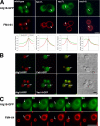
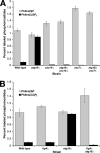
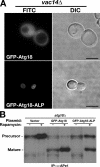
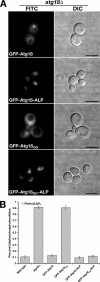
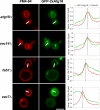
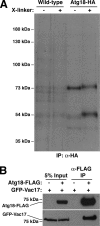
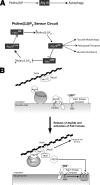
Similar articles
-
Vacuole size control: regulation of PtdIns(3,5)P2 levels by the vacuole-associated Vac14-Fig4 complex, a PtdIns(3,5)P2-specific phosphatase.Mol Biol Cell. 2004 Jan;15(1):24-36. doi: 10.1091/mbc.e03-05-0297. Epub 2003 Oct 3. Mol Biol Cell. 2004. PMID: 14528018 Free PMC article.
-
Regulation of Fab1 phosphatidylinositol 3-phosphate 5-kinase pathway by Vac7 protein and Fig4, a polyphosphoinositide phosphatase family member.Mol Biol Cell. 2002 Apr;13(4):1238-51. doi: 10.1091/mbc.01-10-0498. Mol Biol Cell. 2002. PMID: 11950935 Free PMC article.
-
Fab1p is essential for PtdIns(3)P 5-kinase activity and the maintenance of vacuolar size and membrane homeostasis.J Cell Biol. 1998 Oct 5;143(1):65-79. doi: 10.1083/jcb.143.1.65. J Cell Biol. 1998. PMID: 9763421 Free PMC article.
-
The Fab1 phosphatidylinositol kinase pathway in the regulation of vacuole morphology.Curr Opin Cell Biol. 2005 Aug;17(4):402-8. doi: 10.1016/j.ceb.2005.06.002. Curr Opin Cell Biol. 2005. PMID: 15975782 Review.
-
Phosphoinositide signaling: vac to the future in fab1 kinase regulation.Curr Biol. 2002 Jul 23;12(14):R491-2. doi: 10.1016/s0960-9822(02)00966-1. Curr Biol. 2002. PMID: 12176349 Review.
Cited by
-
Methylglyoxal inhibits nuclear division through alterations in vacuolar morphology and accumulation of Atg18 on the vacuolar membrane in Saccharomyces cerevisiae.Sci Rep. 2020 Aug 17;10(1):13887. doi: 10.1038/s41598-020-70802-8. Sci Rep. 2020. PMID: 32807835 Free PMC article.
-
Phosphatidylinositol 3,5-bisphosphate: low abundance, high significance.Bioessays. 2014 Jan;36(1):52-64. doi: 10.1002/bies.201300012. Epub 2013 Oct 28. Bioessays. 2014. PMID: 24323921 Free PMC article. Review.
-
Charcot-Marie-Tooth disease and intracellular traffic.Prog Neurobiol. 2012 Dec;99(3):191-225. doi: 10.1016/j.pneurobio.2012.03.003. Epub 2012 Mar 22. Prog Neurobiol. 2012. PMID: 22465036 Free PMC article. Review.
-
Structure-based analyses reveal distinct binding sites for Atg2 and phosphoinositides in Atg18.J Biol Chem. 2012 Sep 14;287(38):31681-90. doi: 10.1074/jbc.M112.397570. Epub 2012 Jul 31. J Biol Chem. 2012. PMID: 22851171 Free PMC article.
-
Phosphatidylserine is polarized and required for proper Cdc42 localization and for development of cell polarity.Nat Cell Biol. 2011 Oct 2;13(12):1424-30. doi: 10.1038/ncb2351. Nat Cell Biol. 2011. PMID: 21964439
References
-
- Balla T. Inositol-lipid binding motifs: signal integrators through protein-lipid and protein-protein interactions. J. Cell Sci. 2005;118:2093–2104. - PubMed
-
- Barth H., Meiling-Wesse K., Epple U. D., Thumm M. Autophagy and the cytoplasm to vacuole targeting pathway both require Aut10p. FEBS Lett. 2001;508:23–28. - PubMed
-
- Behnia R., Munro S. Organelle identity and the signposts for membrane traffic. Nature. 2005;438:597–604. - PubMed
Publication types
MeSH terms
Substances
LinkOut - more resources
Full Text Sources
Molecular Biology Databases

